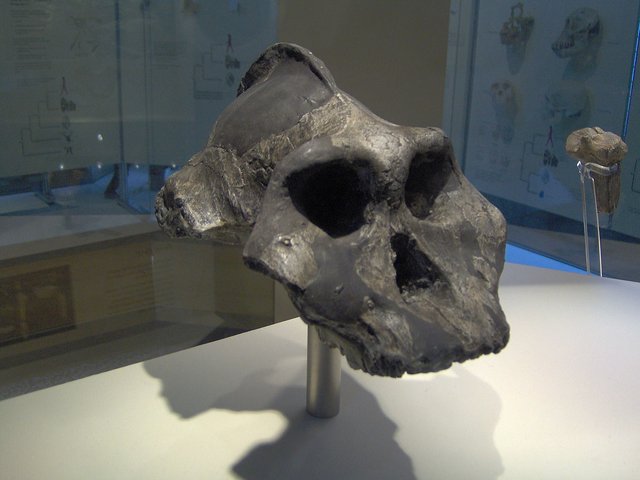Nutcracker man
The most impressive thing about Nutcracker man is the entire set of chewing apparatus. This upright walker would be able to chew pretty much anything and probably did, hence the name. This wonderful set of chompers all boils down to a simple set of genes.
By Photographed by User:Lillyundfreya - Photographed at Westfälisches Museum für Archäologie, Herne, CC BY-SA 3.0, Link
These are the genes that control how chewing muscles (most notably the cheek muscles) are attached to the skull and how strongly they develop.
In the robust Austrolopithicenes or the Paranthropus branch we see that they have retained the set of genes that are now poorly developed in chimps, hominins, humans and the gracile Australopithicenes.
These are the genes that cause the cheek muscles to wrap around over the sides and top of the scull and attach to a piece of bone that develops down the middle of the top of the skull. This bony ridge is called the sagittal crest and is prevalent in most species that have well developed jaws and a strong bite.
By Nrkpan , CC BY-SA 3.0, Link
The most significant drawback to this set of genes is that the strong muscles wrap around over the top of the scull and cramp the brain from getting significantly larger.
Consequently, this set of genes being knocked out allowed for the attachment of the jaw muscles to the side of the head and enabled the growing brain to expand freely as tool use, language and other cultural advancement stimulated the brain.
As a result of the lessening of the jaws muscular and attachment structure it was necessary to diminish the size of the jaws and teeth. This was not a problem from an eating perspective since by then hominins had tamed fire and figured out how to cook food etc.
In modern humans the jaws are now comparatively so small that we don't have enough room for all the teeth we have inherited from our ancestors. Consequently we suffer from wisdom teeth impaction and other space related dental issues.

Awesome, now I no who to curse next time my wisdom teeth hurt!!
That was a great read!
Wow, what a great job done by mother Nature! It's so amazing and interesting. Anyway, thanks to her for being I able to think more than chew now. And I'm willing to suffer a little bit of wisdom teeth, so that my brain is like this. But evolution is still going on, I suppose. Who knows what changes await future descendants. Now people go a little, riding in the car, etc. Maybe in thousands of years, our feet will be unrecognizable and our brain will have limitless possibilities. What do you think, in what direction human evolution will step?
It’s not hard to understand why Paranthropus boisei is often called the Nutcracker Man. The hominid’s massive molars and enormous jaw make it seem pretty obvious that the species spent a lot of time chomping on hard nuts and seeds. Yet, the only direct evidence of P. boisei‘s meals—the chemistry and microscopic scratches of the teeth—hint that the species probably didn’t crack nuts all that much, instead preferring the taste of grass. A team of anthropologists that recently reviewed the possible diets of several early hominid species has highlighted this paradox of the Nutcracker Man and the difficulties in reconstructing the diets of our ancient kin. The first place anthropologists start when analyzing diet is the size and shape of the hominid’s teeth and jaws. Then they look for modern primates that have similar-looking dentition to see what they eat. For example, monkeys that eat a lot of leaves have molars with sharp cusps for shearing the tough foliage. On the other hand, monkeys that eat a lot of fruit have low, rounded molar cusps. If you found a hominid with either of those traits, you’d have a starting point for what the species ate. But the morphology of a species’ teeth and jaws only shows what the hominid was capable of eating, not necessarily what it typically ate. In some cases, these physical traits might reflect the fallback foods that a species relied on when its preferred foods were unavailable during certain times of the year.
And it is so painful when that happens, the headache due to impacted wisdom teeth is too intense.
Didn't know the causes though, nice article
that's a good information on science,,
Thanks for sharing
wow! Great !! Honestly, I just now, thanks to you, understood why wisdom teeth cause inconvenience, and generally grow so late. Thank you! It's amazing!
Nice post
Fantastic skull and reconstruction! I always wonder what it would have been like to have more than one human species around and interacting.
Evolution is amazing. Thank you!
This is interesting information